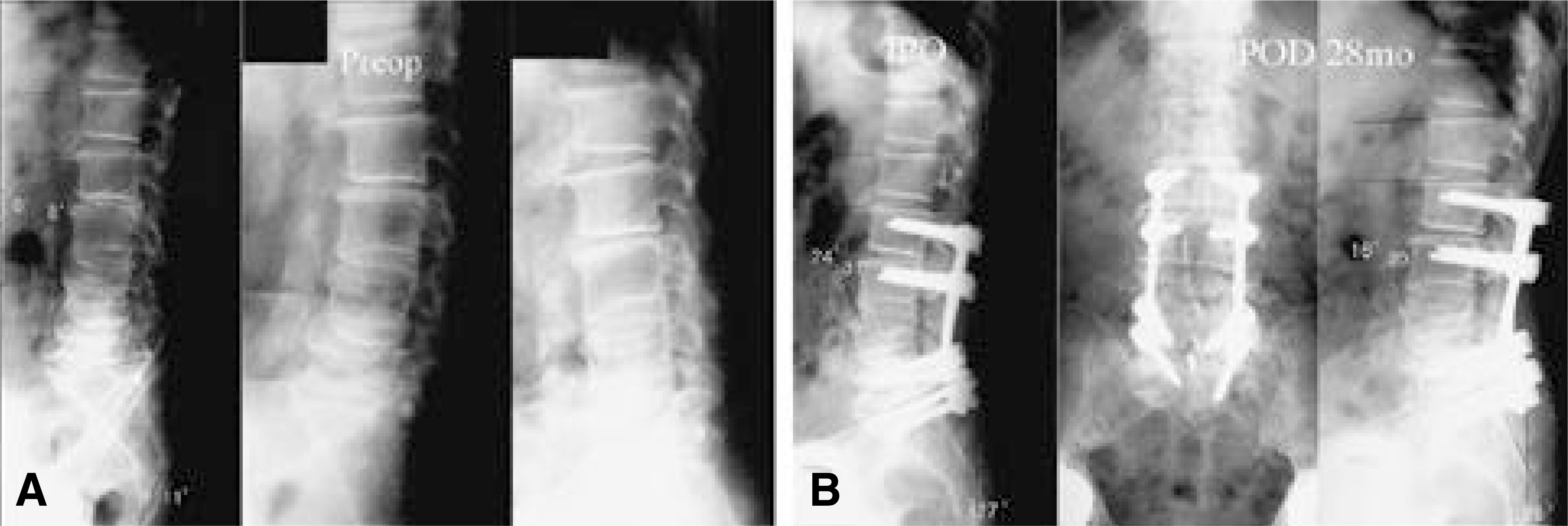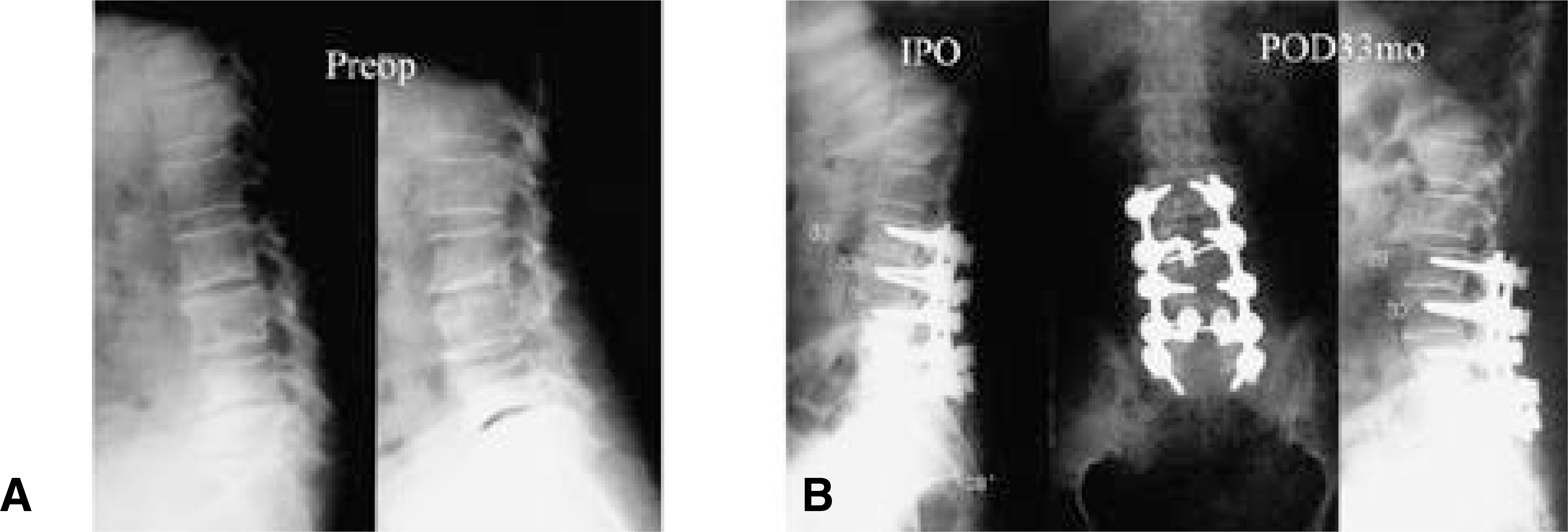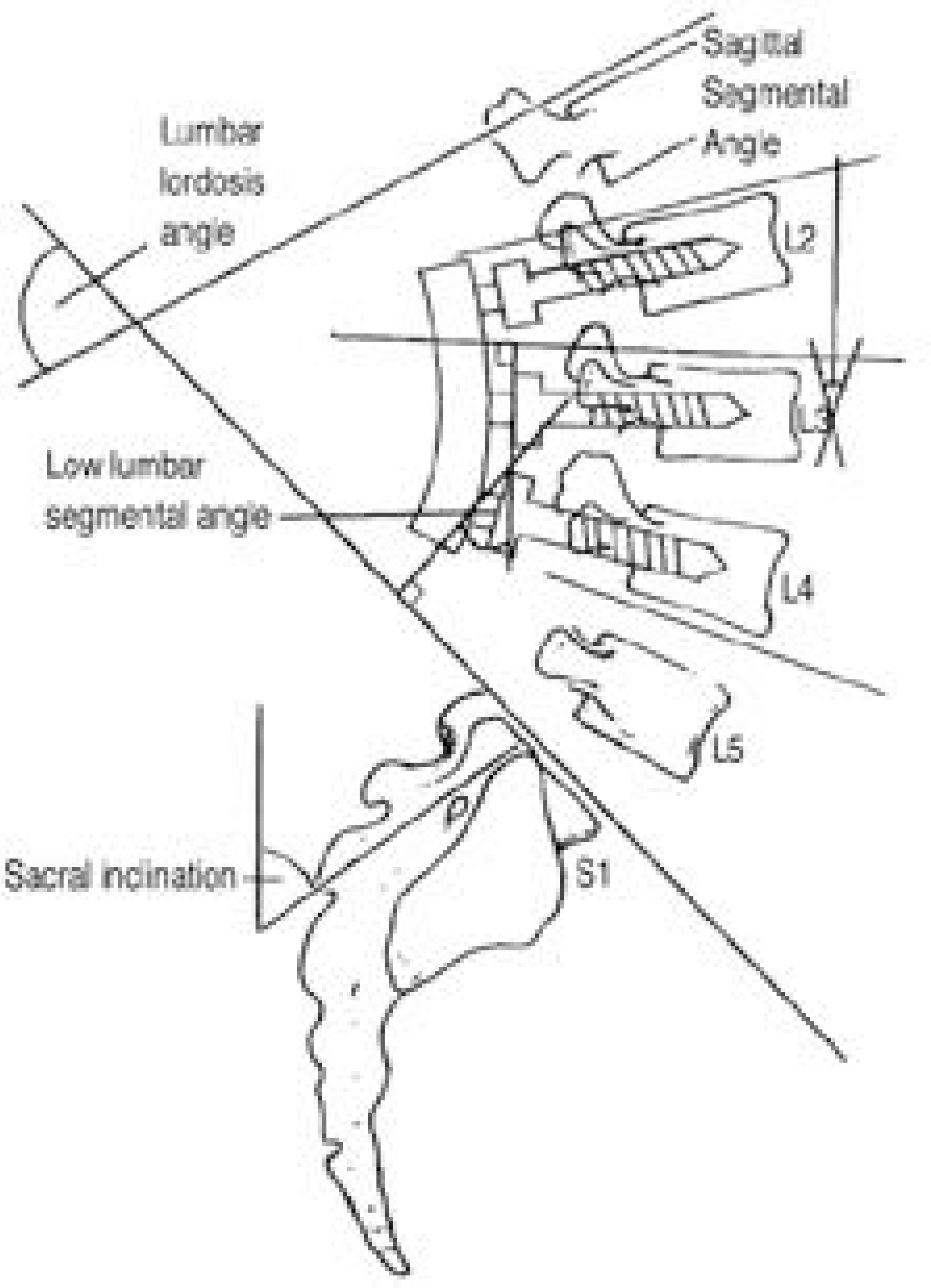Abstract
Objective
To analyse associated preoperative conditions and postoperative causes of sagittal imbalance and to analyze clinical results of surgical treatment of lumbar degenerative kyphosis.
Summary of Literature Review
There have been many controversies and high possibility of unsatisfactory results in surgical treatment of symptomatic degenerative lumbar kyphosis, which was complicated condition usually needed multi- level operation in old age.
Materials and Methods
We analyzed 24 patients who complained of long standing stooping as one of main symptoms with radiologically measured lumbar kyphosis and underwent surgical restoration of lumbar lordodsis with long segmental spinal fusion from 1995 to 1999. Mean followup was 31.9months(from 24 to 48 months). Operative treatments were posterolateral fusion with pedicular screw(15 cases), anterior and posterior interbody fusion(5 cases), posterior interbody fusion with cage(1 case) and decancellation osteotomy(3 cases). Cases divided into 2 groups(Group A : improved stooping, Group B: recurred stooping) were evaluated by radiological measurement of changes in surgically restored lumbar lordosis correlated with clinical improvement of stooping. Overall clinical results were evaluated according to Kirkaldy-Willis criteria.
Results
The associated conditions of preoperative lumbar kyphosis were recognized as multiple disc degeneration, segmental instability, degenerative vertebral wedging and pseudospondylolisthesis. Postoperative stooping recurred in 5 cases and caused by adjacent kyphosis in 2 cases, loss of correction in 1 case and both in 2 cases. Loss of correction was associated with pseudarthrosis in 1 case, screw loosening in 3 cases and allograft collapse in 2 cases. A ccording to Kirkaldy-Willis, 8 cases of unsatisfactory clinical results consisted of 3 cases of pseudarthrosis out of 19 cases of Gruop A and all cases(5 cases) in group B. Most of correction loss occurred at lower lumbar spine(L3- S1) and was closely related to postoperative sagittal imbalance.
REFERENCES
1). Aaro S, Ohlen G. The effect of Harrington instrumentation on the sagittal configuration and mobility of the spine in scoliosis. Spine. 8(6):570–575. 1983.

2). Andersson BJG, Ortengren R. Myoelectric back muscle activity during sitting. Scand J Rehab Med. 3(Suppl):73–90. 1974.
3). Atsuta Y. Degenerative kyphosis in advanced age; Cause and management(in Japanese). J Jpn Orthop Assoc, 37-. 3:289–295. 1994.
4). Becker's L, Bekaert J. The role of lordosis. Acta Orthop Belg. 57(Suppl):198–202. 1991.
5). Bernhardt M, Bridwell KH. Segmental analysis of the sagittal plane alignment of normal thoracic and lumbar spines and thoracolumbar junction. Spine. 14:717–721. 1989.
7). Deniel E, Geib MD, Lawrence G, Lenke MD, Keith H, Bridwell MD, Kathy Blanke RN, Kevin W, McBn-ery MD. An-Analysis of Sagittal Spinal Alignment in 100 Asymptomatic Middle and Older Aged Volunteers. Spine. 20:1351–1358. 1995.
8). Doherty JH. Complication of fusion in lumbar scoliosis. J Bone Joint Surg. 55-A:438. 1973.
10). Grobler LJ, Moe JH, Winter RB, et al. Loss of lumbar lordosis following surgical correction of thoracolumbar deformity, Orthop Trans. 2(2):39. 1978.
11). Hadar H, Godoth N, Heifetz M. Fatty replacement of lower paraspinal muscles, normal and neuromuscular dis -oders. AJR. 141:895–898. 1983.
12). Kirkaldy-Willis WH, Paine KWE, Cauchoix J, Mcl-vor G. Lumbar Spinal Fusion: A biomechanical study, Spine. 9:574–581. 1984.
13). Lee CS, Kim YT, Kim EG. Clinical Study of Lumbar Degenerative Kyphosis. J Korean Spine Surg. 4(1):27–35. 1997.
14). Lee JS, Oh WH, Chung SS, Lee SG, Lee JY. Analysis of the Sagittal Alignment of Normal Spines. J Korean Orthop. 34:949–954. 1999.

15). Michael OLG. Loss of lumbar lordosis: A complication of spinal fusion for scoliosis. Orthop. Clin. N AM, 19-. 2:383–393. 1988.
16). Moe JH, Denis F. The iatrogenic loss of lumbar lordosis. Orthop Trans. 1-2:131. 1977.
17). Stagnara P, De Mauroy JC, Dran G, et al. Reciprocal angulation of vertebral bodies in sagittal plane: Approach to references in the evaluation of kyphosis and lordosis. Spine. 7:335–342. 1982.
18). Takemitsu Y, Harada Y, Iwahara T, Miyamoto M, Mitatake Y. Lumbar Degenerative Kyphosis: Clinical, radiologic and epidemiological study. Spine. 13:1317–1326. 1988.
19). Takemitsu Y, Harada Y, Iwahara T. Low back pain and aging change of spine in Japanese farmers aged more than 40 years. J Jpn Orthop Assoc. 58:551–552. 1984.
20). Wambolt A, Spencer DL. A segmental analysis of the distribution of lumbar lordosis in the normal spine. Orthop Trans. 11:92–93. 1987.
21). Winter RB. Harrington instrumentation into the lumbar spine, technique for preservation of normal lumbar lordosis. Spine. 11(9):633–635. 1986.
22). Yohichi Aota, Kiy oshi Kumano, and Shigeru Hiraba-yashi. Postfusion instability at the adjacent Segments after rigid pedicle screw fixation for degenerative lumbar spinal disorders. Journal of Spinal Disorders. 8(6):464–473. 1995.
Figures and Tables%
Fig. 2-A.
Preoperative lateral radiography of 68-year-old man shows disc degeneration of L2-3 L3-4 L4-5 L5-S1, and rigid kyphosis in flexion-extension view. Fig. 2-B. Postoperative lateral radiography with L2-S1 posterolateral fusion with pedicular screw and pedicle subtraction osteotomy on L4 shows increased lumbar lordosis angle by 16˚. Postoperative 28-months followup lateral radiography of lumbar spine shows correction loss(L1-S1) by 8˚, but shows maintenance of lumbar lordosis and relief of stooping.

Fig. 3-A.
Preoperative lateral radiography of 64-year-old woman shows disc degeneration of L4-5 L5-S1, wedge vertebrae L4 L5, and segmental instability L3-4 L4-5 in flexion-extension view. Fig. 3-B. Postoperative lateral radiography with L2-S1 posterolateral fusion with pedicular screws and L2-5 anterior interbody fusion with allograft shows increased lumbar lordosis angle by 15˚. Postoperative 33-months followup lateral radiography of lumbar spine shows compression fx L1 with correction loss(L1-S1) by 4˚, but showed maintenance of lumbar lordosis and relief of stooping.

Fig. 4-A.
Preoperative lateral radiography of 66-year-old woman shows disc degeneration of L2-3 L4-5 L5-S1, wedge vertebrae L5 and pseudospondylolisthesis L3 on 4. Fig. 4-B. Postoperative lateral radiography with L2-S1 posterolateral fusion with pedicular screw and posterior lumbar interbody fusion with cage L4-5 shows increased lumbar lordosis angle by 11˚. Postoperative 33-months followup lateral radiography of lumbar spine shows correction loss(L1-S1) by 4˚, but showed maintenance of lumbar lordosis and relief of stooping.

Table 1.
Radiologic Results in Improved stooping group (Group A)
| Preop | IPO | F/U | Loss of Correction | |
|---|---|---|---|---|
| FSA*(In-fusion) | 9.8 | 24.7 | 21.3 | 3.4 |
| TLLA†(L1-S1) | 14.1 | 30.3 | 26.2 | 4.1 |
| HLSA‡(L1-L3) | –7.5 | 0.1 | –2.1 | 2.2 |
| LLSA§(L3-S1) | 18.6 | 30.8 | 28.4 | 2.4 |
| SI||(ß-Angle) | 19.8 | 34.3 | 32.1 | 2.2 |
Table 2.
Radiologic Results in Persistent stooping group (Group B)
| Preop | IPO | F/U | Loss of Correction | |
|---|---|---|---|---|
| FSA(In-fusion) | 4.4 | 25.6 | 16.2 | 9.4 |
| TLLA(L1-S1) | 10.9 | 31.3 | 19.8 | 11.5 |
| HLSA(L1-L3) | –2.4 | 2.6 | 0.2 | 2.4 |
| LLSA(L3-S1) | 16.8 | 26.8 | 16.0 | 10.8 |
| SI(ß-Angle) | 24.0 | 35.8 | 26.2 | 9.6 |
Table 3.
Associated conditions for lumbar kyphosis
| Cause | Case(%) |
|---|---|
| Multiple Disc Degeneration | 24 case(100) |
| Wedge or Collapsed vertebrae | 7 case(29.1) |
| Segmental Instability | 8 case(33.3) |
| Pseudospondylolisthesis | 4 case(16.6) |
Table 4.
Causes of Postoperative Sagittal Imbalance
| Cause | Case(%) | Location |
|---|---|---|
| Pseudarthrosis | 1 case(4.1) | 1 case(L5-S1) |
| Screws Loosening | 3 cases(12.5) | 3 cases(L3-S1) |
| Allograft collapse | 2 cases(8.3) | 2 cases(L3-S1) |
| Adj∗. Disc Degeneration | 3 cases(12.5) | 2 cases(L5-S1),1 case(L1-2) |
Table 5.
Associated neural compression
| Cause | Case(%) |
|---|---|
| Spinal stenosis | 20 cases(83.3) |
| HNP | 14 cases(58.3) |




 PDF
PDF ePub
ePub Citation
Citation Print
Print



 XML Download
XML Download